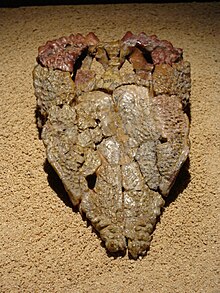Goyocephale lattimorei
|
Goyocephale Temporal range: Late Cretaceous, 76 Ma |
|
|---|---|
 |
|
| Holotype skull, dorsal view | |
| Scientific classification | |
| Kingdom: | Animalia |
| Phylum: | Chordata |
| Clade: | Dinosauria |
| Order: | †Ornithischia |
| Family: | †Pachycephalosauridae |
| Genus: |
†Goyocephale Perle et al., 1982 |
| Species: | †G. lattimorei |
| Binomial name | |
|
Goyocephale lattimorei Perle et al., 1982 |
|
Goyocephale is an extinct genus of pachycephalosaurian ornithischian that lived in Mongolia during the Late Cretaceous about 76 million years ago. It was first described in 1982 by Perle, Maryańska and Osmólska for a disarticulated skeleton with most of a skull, part of the forelimb and hindlimb, some of the pelvic girdle, and some vertebrae. Perle et al. named the remains Goyocephale lattimorei, from the Mongolian goyo, meaning "decorated", and the Ancient Greek kephale, for head. The species name honours Oven Lattimore.
Goyocephale is known from a partial skull, including both mandibles, the skull roof, part of the occiput, part of the braincase region, the posterior skull, the premaxilla, and the maxilla. The posterior edge of the skull roof, at the edge of the squamosal bones, has many small bony bumps, which would have been the base of small horns in life. A feature shared with pachycephalosaurids, Goyocephale had a heterodont dentition, with large caniniform premaxilla teeth, followed by a diastema between the premaxilla and the maxilla, and the regular sub-triangular teeth in the maxilla. Teeth in the premaxilla become larger farther posterior, with the last being the largest. The mandible teeth are similar, with the first tooth being caniniform, and the remainder low and sub-triangular.
...
Wikipedia
